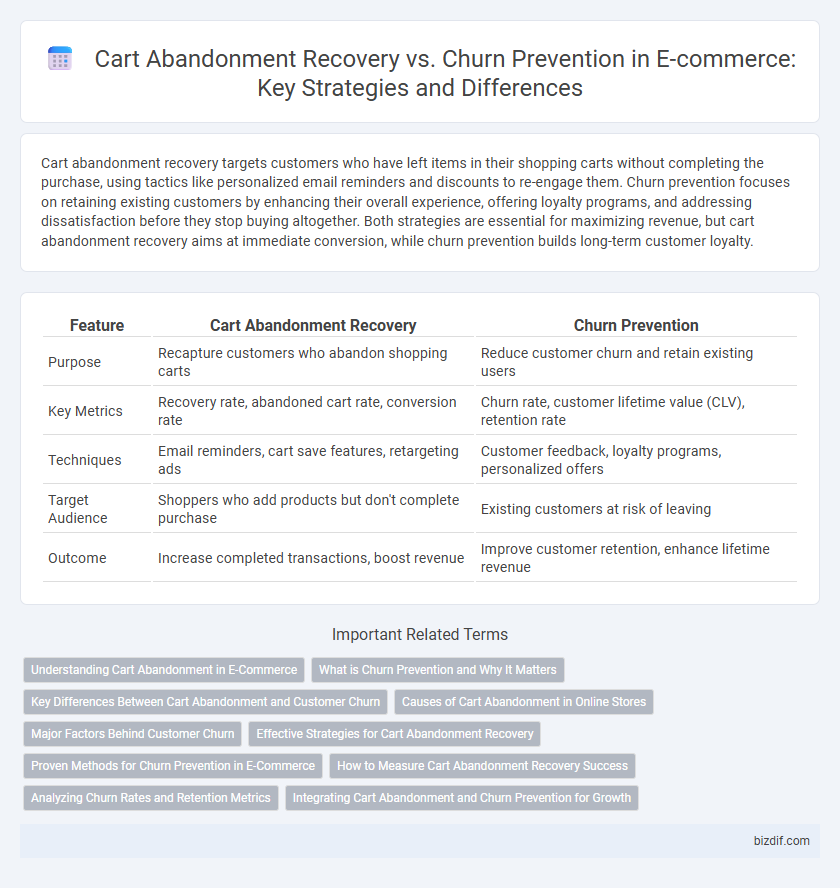Cart abandonment recovery targets customers who have left items in their shopping carts without completing the purchase, using tactics like personalized email reminders and discounts to re-engage them. Churn prevention focuses on retaining existing customers by enhancing their overall experience, offering loyalty programs, and addressing dissatisfaction before they stop buying altogether. Both strategies are essential for maximizing revenue, but cart abandonment recovery aims at immediate conversion, while churn prevention builds long-term customer loyalty.
Table of Comparison
| Feature | Cart Abandonment Recovery | Churn Prevention |
|---|---|---|
| Purpose | Recapture customers who abandon shopping carts | Reduce customer churn and retain existing users |
| Key Metrics | Recovery rate, abandoned cart rate, conversion rate | Churn rate, customer lifetime value (CLV), retention rate |
| Techniques | Email reminders, cart save features, retargeting ads | Customer feedback, loyalty programs, personalized offers |
| Target Audience | Shoppers who add products but don't complete purchase | Existing customers at risk of leaving |
| Outcome | Increase completed transactions, boost revenue | Improve customer retention, enhance lifetime revenue |
Understanding Cart Abandonment in E-Commerce
Cart abandonment in e-commerce occurs when shoppers add items to their online shopping cart but leave the site before completing the purchase, resulting in lost sales opportunities. Understanding the key factors driving cart abandonment, such as unexpected costs, complicated checkout processes, and lack of payment options, enables businesses to implement targeted recovery strategies. Effective cart abandonment recovery techniques include personalized email reminders, retargeting ads, and simplified checkout experiences to convert potential buyers into customers and minimize revenue loss.
What is Churn Prevention and Why It Matters
Churn prevention refers to strategies and tactics used by e-commerce businesses to retain customers and reduce the rate at which they stop purchasing or unsubscribe from services. It matters because retaining existing customers is more cost-effective than acquiring new ones, directly impacting revenue stability and customer lifetime value. Effective churn prevention involves personalized communication, loyalty programs, and proactive engagement to address customer pain points and maintain satisfaction.
Key Differences Between Cart Abandonment and Customer Churn
Cart abandonment refers specifically to customers who add products to their online shopping cart but leave without completing the purchase, typically driven by factors like high shipping costs or complicated checkout processes. Customer churn involves the broader phenomenon of customers ceasing all interactions or purchases with a brand over time, often caused by dissatisfaction or better offers from competitors. While cart abandonment recovery targets real-time interventions to complete a single transaction, churn prevention focuses on long-term customer retention strategies including loyalty programs and personalized communication.
Causes of Cart Abandonment in Online Stores
High shipping costs, complicated checkout processes, and lack of trust in payment security are primary causes of cart abandonment in online stores. Customers often abandon carts due to unexpected fees, slow website performance, or limited payment options, highlighting critical areas for optimization. Understanding these factors helps tailor cart abandonment recovery strategies and enhances churn prevention efforts in e-commerce.
Major Factors Behind Customer Churn
High cart abandonment rates often signal friction in the checkout process, including unexpected costs, complicated navigation, or limited payment options, driving customers away before purchase completion. Poor post-purchase experiences and lack of personalized engagement contribute significantly to customer churn by reducing satisfaction and loyalty. Effective churn prevention strategies focus on improving user experience, targeted communication, and timely incentives to retain customers and convert abandoned carts into sales.
Effective Strategies for Cart Abandonment Recovery
Effective strategies for cart abandonment recovery in e-commerce include personalized email reminders with dynamic product recommendations and limited-time discounts that create a sense of urgency. Implementing retargeting ads across social media platforms and optimizing the checkout process by reducing friction points such as lengthy forms or unexpected shipping costs significantly increases conversion rates. Utilizing behavioral analytics to identify drop-off patterns allows businesses to tailor interventions that re-engage customers and reduce lost sales opportunities.
Proven Methods for Churn Prevention in E-Commerce
Proven methods for churn prevention in e-commerce include personalized email campaigns based on browsing behavior and purchase history, targeted discounts or loyalty rewards to incentivize repeat purchases, and proactive customer support through chatbots or live agents to resolve issues promptly. Implementing predictive analytics helps identify at-risk customers by analyzing engagement metrics and transactional data, enabling timely intervention before churn occurs. Enhancing user experience with seamless navigation, fast checkout processes, and transparent return policies also significantly reduces the likelihood of customer attrition.
How to Measure Cart Abandonment Recovery Success
Measuring cart abandonment recovery success involves tracking key metrics such as recovery rate, conversion rate of recovered carts, and the average time taken to complete abandoned transactions. Analyzing user behavior through tools like abandoned cart emails, push notifications, and retargeting campaigns reveals their effectiveness in reducing lost sales. Evaluating repeat purchase rates and customer lifetime value after recovery efforts helps gauge long-term impact on churn prevention and overall ecommerce revenue growth.
Analyzing Churn Rates and Retention Metrics
Analyzing churn rates and retention metrics provides critical insights for optimizing cart abandonment recovery strategies by identifying when and why customers disengage from the purchase funnel. High cart abandonment rates often correlate with initial churn indicators, enabling targeted interventions that enhance customer retention and lifetime value. Leveraging data such as exit intent, session duration, and repeat visit frequency refines personalized recovery campaigns to reduce churn and boost conversion rates effectively.
Integrating Cart Abandonment and Churn Prevention for Growth
Integrating cart abandonment recovery with churn prevention strategies significantly boosts e-commerce growth by addressing both immediate sales opportunities and long-term customer retention. Leveraging personalized email campaigns triggered by cart abandonment data alongside loyalty programs that reduce churn fosters seamless customer experiences and higher lifetime value. Combining behavioral analytics with targeted incentives creates a cohesive approach that maximizes revenue and strengthens brand loyalty.
Cart Abandonment Recovery vs Churn Prevention Infographic

 bizdif.com
bizdif.com